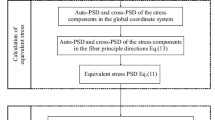Abstract
A vibration aging test is a part of equipment qualification. When the vibration level is too high for the shaker system, the equivalent test can be accomplished by bandsplitting and/or time-level trade techniques. This paper discusses the power spectral density (PSD) band-splitting effect on fatigue damage and a method for the application to PSD bandsplitting. Three types of acceleration PSDs—band-limited white noise (BLWN) PSD, unimodal PSD, and bimodal PSD—with various shapes were chosen as target PSDs. Oritz and Chens method, and Benascuitti and Tovo’s method were used to calculate fatigue damage spectra (FDS). The maximum values of fatigue damage ratios for all target PSDs were calculated. It was found that PSD overlapping can be used to compensate for the lack of fatigue damage due to PSD band-splitting. An application example of the suggested method that enables conservative testing when applying PSD band-splitting is presented herein.
Similar content being viewed by others
Abbreviations
- A :
-
Amplitude of PSD (g2/Hz)
- a n :
-
Coefficient of enveloping function, for Eq. (23)
- D NB :
-
The fatigue damage under a narrow-band random process, defined in Eq. (14)
- D 0C :
-
The fatigue damage under a wide-band random process, defined in Eq. (11)
- D BT :
-
The fatigue damage under a wide-band random process, defined in Eq. (17)
- E[0+]:
-
Expected rate of zero up-crossing
- f :
-
Frequency (Hz)
- f n :
-
Natural frequency (Hz)
- f mi :
-
Peak frequency of target PSD (Hz)
- G(f) :
-
PSD function (g2/Hz)
- G(f) :
-
Input acceleration PSD
- G z(f, f n, ζ):
-
Relative displacement RPSD
- \({G_{{S_a}}}\left( {f,{f_n},\zeta } \right)\) :
-
Stress RPSD
- γ :
-
Irregularity factor
- Γ(·):
-
The gamma function
- H(f, f n, ζ):
-
Transfer function
- K :
-
Coefficient relating a relative displacement to a stress amplitude, refer to Eq. (9)
- m :
-
Fatigue exponent (slope factor of the S-N curve)
- M n :
-
N-th moment of PSD
- N :
-
Number of cycles
- S a :
-
Alternating stress
- S1 :
-
Severity (RMS) at test condition
- S2 :
-
Severity (RMS) at in-service condition
- t2 :
-
Equivalent test time
- t2 :
-
In-service time for specified condition
- X m :
-
Normalized mean frequency
- ζ :
-
Damping ratio
- z :
-
Relative displacement
References
Nuclear Regulatory Commission, 10 CFR Appendix A to Part 50-General Design Criteria for Nuclear Power Plants (2011).
IEC, Nuclear Facilities — Equipment Important to Safety — Seismic Qualification, IEC/IEEE 60980-344, IEEE International Standard, IEC (2020).
Department of Defense, Environmental Engineering Considerations and Laboratory Tests, MIL-STD-810H, Department of Defense Test Method Standard, Department of Defense, USA (2019).
Vibrationdata, PSD Bandsplitting, https://vibrationdata.wordpress.com/2013/04/13/psd-bandsplitting/.
T. Dirlik, Application of computers in fatigue analysis, Ph.D. Thesis, University of Warwick (1985).
G. R. Henderson and A. G. Piersol, Fatigue damage related descriptor for random vibration test environments, Sound and Vibration, 29(10) (1995) 20–25.
J. P. Quigley, Y.-L. Lee and L. Wang, Review and assessment of frequency-based fatigue damage models, SAE International J. of Materials and Manufacturing, 9(3) (2016) 565–577.
K. Oritz and N. K. Chen, Fatigue damage prediction for stationary wide-band stresses, 5th International Conference on the Applications of Statistics and Probability in Civil Engineering, Vancouver, Canada (1987).
D. Benasciutti, Fatigue analysis of random loadings, Ph.D.Thesis, University of Ferrara, Department of Engineering (2004).
L. D. Lutes and C. E. Larsen, Improved spectral method for variable amplitude fatigue prediction, J. of Structural Engineering, 116(4) (1990) 1149–1164.
J. Xia et al., Comparison of fatigue life prediction methods for solder joints under random vibration loading, Microelectronics Reliability, 95 (2019) 58–64.
D. Benasciutti and R. Tovo, Spectral methods for lifetime prediction under wide-band stationary random processes, International J. of Fatigue, 27(8) (2005) 867–877.
S.-D. Wu et al., Fatigue life prediction based on modified narrowband method under broadband random vibration loading, International J. of Fatigue, 159 (2022) 106832.
L. Campello, Simulation model and experimental validation for estimation of fatigue damage due to random vibration, Master’s Thesis, Politecnico di Torino (2021).
T. Dirlik and D. Benasciutti, Dirlik and tovo-benasciutti spectral methods in vibration fatigue: a review with a historical perspective, Metals, 11(9) (2021) 1333.
W. H. Lee, J. S. Park and J. M. Kim, Preliminary study on fatigue damage of band split PSD, Transactions of the Korean Nuclear Society Spring Meeting (2021).
Ansys®, Mechanical APDL Release 19.0, ANSYS, Inc.
A. G. Piersol and T. L. Paez, Harris’ Shock and Vibration Handbook, Sixth Edition, McGraw-Hill (2009).
U.S. Nuclear Regulatory Commission, Damping Values for Seismic Design of Nuclear Power Plants, Regulatory Guide 1.61, Revision 1, U.S. NRC (2007).
ASTM International, Standard Practices for Cycle Counting in Fatigue Analysis, ASTM E1049-85 (2017).
Acknowledgments
This study is financially supported by KETEP in Korea (Grant No. 20193110100020).
Author information
Authors and Affiliations
Corresponding author
Additional information
Wonho Lee is an engineer for the Mechanical System Engineering Department of KEPCO-E&C, Daejeon, Korea. He received his B.E. in 2013 in Mechanical Engineering from Handong Global University. His research interests include vibration and fatigue of nuclear components.
Jinseok Park is an engineer for the Mechanical System Engineering Department of KEPCO-E&C, Daejeon, Korea. He received his M.S. in 2005 in Precision Mechanical Engineering from Hanyang University. His research interests include vibration and fatigue of nuclear components.
Jongmin Kim is an engineer for the Mechanical System Engineering Department of KEPCO-E&C, Daejeon, Korea. He received his M.E. in 1990 in Mechanical Engineering from Inha University. His research interests include design and fatigue of nuclear components.
Rights and permissions
About this article
Cite this article
Lee, W., Park, J. & Kim, J. A study on the band split of power spectral density for a vibration test. J Mech Sci Technol 36, 5011–5017 (2022). https://doi.org/10.1007/s12206-022-0913-0
Received:
Revised:
Accepted:
Published:
Issue Date:
DOI: https://doi.org/10.1007/s12206-022-0913-0




